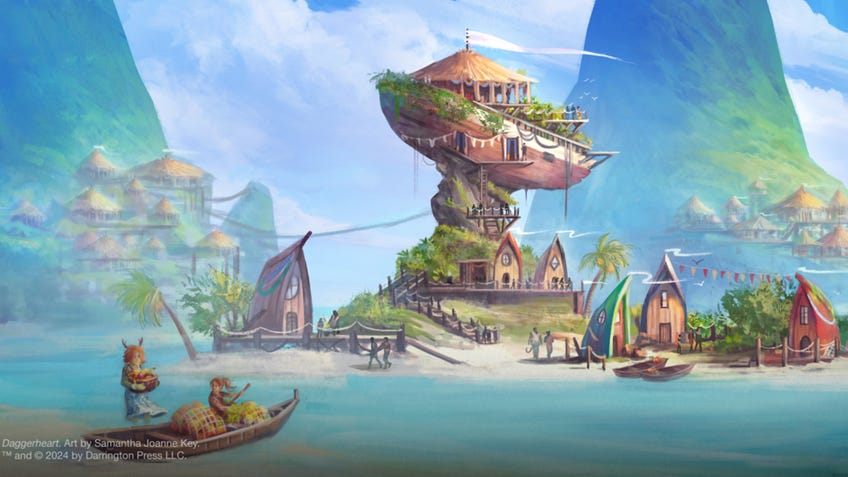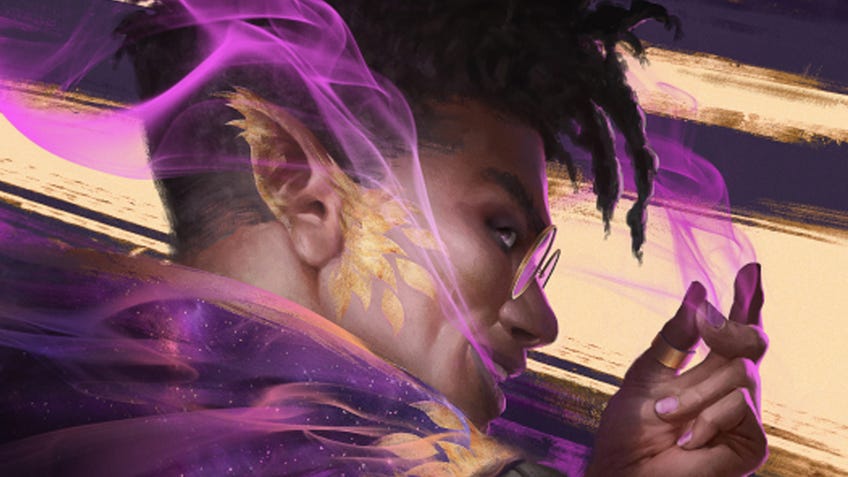Critical Role's D&D rival Daggerheart plays tabletop RPGs' greatest hits well, but struggles to be more than a covers band
For all the smart evolution it makes from its forebears, the fantasy RPG is still searching for its own identity.
The elevator pitch for Daggerheart is pretty exciting. Critical Role, the biggest poster child of the biggest RPG on the market, is taking a shocking turn away from Dungeons & Dragons, the game on which it built its success, and looking to create its own system that looks to redefine the standards for epic fantasy RPGs. Daggerheart is only in its playtest stage ahead of a full release next year, but the game is clearly aiming for the heights with this first public beta, and looking to carve out its own identity under the shadow of the game that spawned it.
After D&D, Daggerheart lists various inspirations as disparate as Borderlands, Earthsea and Slugblaster: Kickflip Over a Quantum Centipede, but its general tone is summed up quite nicely at the start of the player principles: “Be a fan of your character and their journey.” This lofty urging to experience the game both as an onlooker who demands healthy party dynamics and dangerous adversaries that never quite stop the group in their tracks is quite illuminating, and is essentially what sits at the heart of Daggerheart’s echoes of Fifth Edition: the desire to replicate the features that have made D&D not simply a lasting game, but an enduring cinematic baseline for the production of RPG games that fulfil not only a handful of players, but thousands of fans.
The first way that Daggerheart tries to get this across is its central action resolution system: the Hope and Fear dice. All actions are resolved with two colour-coded d12s, one for ‘Hope’ and one for ‘Fear’; dice are rolled and totalled to come up with a final score to beat checks, noting whether the Hope or Fear die rolls higher. If Hope rolls higher, players take a hope. If fear rolls higher, the GM takes a fear. Both are points that can be later spent to either help or hinder the players. The system seems highly reminiscent of the Chaos/Momentum dynamic that existed in Modiphius’ Dishonored RPG (also listed among the game’s inspirations), providing a stockpile of resources that builds as the game progresses; hope is spent by players to help them, fear is spent by the GM against them.
Daggerheart works very well at being a cinematic system in which player cohesion and satisfaction comes first and foremost.
Fear, like Dishonored’s Chaos, presents a great solution to the challenges of fail-forward systems. ‘Fail-forward’ refers to a style of play in which, instead of simply failing to achieve a desired result, low dice rolls still succeed but add additional complications to a scene. An issue that this often runs into is that the requirement to constantly add complications can feel like needless contrivance, adding complications way beyond the initial scope of the scene. Fear still encourages on-the-fly complications, but also provides a reservoir of karmic backlash that the GM can redeploy into play at any time.
This system kills two birds with one stone - GMs can delay consequences for somewhere that makes more narrative sense, and players feel less hard done by when a left-field complication is drawn from a measurable resource. All of this manifests in what feels like Daggerheart’s biggest draw; it works very well at being a cinematic system in which player cohesion and satisfaction comes first and foremost.

In fact, Daggerheart in its roleplay stage basically feels like it’s playing the hits. We have clocks from Blades in the Dark, partial successes from Powered by the Apocalypse, chaos from Dishonored, talents from Lancer. But the game’s most left-field decisions come in its departure from D&D combat, moving from 5E’s turn-based system to a completely freeform combat environment.I can’t say that I don’t see the vision here. Turn-based combat systems restrict play to a tiny area within combat, where the experience of waiting for your turn to come around can turn into a torturous waiting game, so recommending player engagement with combat as and when it works narratively is a good fix. Particularly, Daggerheart places great emphasis on party dynamics; playing fast and loose with turn orders means that parties can set up synergistic moves between members, encouraged by tag-team rolls in which players combine hope to act in tandem.
Daggerheart feels like it should be a game about combat but, as things currently stand, it’s massively underdeveloped.
But the solution here opens up more problems. A well-run fight still involves all the players and enemies getting regular chances to show off their abilities - so the requirements that lead to turn-based systems are still there, but all the work of running it has just been shifted from the rule system to the GM, who is forced to wrest control away from outgoing players in order to ensure everyone is getting their time in the sun.
All of this might be fine in a system where combat is less important, but Daggerheart retains a clear vestigial focus on combat in its character builds and abilities from its crunchy D&D forebears. So, in order for character choices to be realised, combat has to be regularly visited - despite the fact that running it often turns into a massive headache where constant GM supervision is required to stop players from oscillating between brazen temerity and self-conscious timorousness. Essentially, Daggerheart feels like it should be a game about combat, given the amount of rules devoted to it (particularly in character creation), but, as things currently stand, combat feels like it’s massively underdeveloped.

There are a few other things here that follow the same critique; changes made in the name of time-saving that ultimately feel as though they create more work. For example, money and range are both abstracted into generalised bands like ‘a hoard’ and ‘very close’, both of which sound fine until you find yourself completely dumbstruck by questions like “How far can this enemy run?” and “How much does this sword cost?” (both things usually resolved by performing a slapdash recreation of the numerical systems that they were designed to replace).
Daggerheart works surprisingly well in small doses, but fundamentally it’s not much more than a concatenation of D&D holdovers and recognisable mechanics collected around a bright, sanitary epic-fantasy aesthetic.
The main area in which Daggerheart wants to retain some of D&D’s typical crunch is character creation. Players choose ancestries, classes and subclasses, but swap in and out abilities on ‘cards’, similar to a perk loadout system in a video game. The approach generally works quite well - character creation has been surprisingly easy, although the actual tactile experience of moving cards in and out of play seems needlessly complex. Additionally, I can’t help but ascribe a cynical view to Daggerheart’s focus on decks of ability cards and colour-coded dice. I will be wholly unsurprised if, once Daggerheart hits the market in its final iteration, it does so accompanied by a host of branded paraphernalia intended to goad die-hard fans and inexperienced marks into overspending on a game that, fundamentally, should only require pencil, paper and some bog-standard polyhedrals.
The final result is that Daggerheart works surprisingly well in small doses. The game seems effectively set up for established groups - but, fundamentally, it’s not much more than a concatenation of D&D holdovers and recognisable mechanics collected around a bright, sanitary epic-fantasy aesthetic. Daggerheart is certainly recommendable in its current state for the right type of session, but there is still a long way to go before the game will be able to create an identity for itself away from the industry titans that formented its creation.

